Project Report: University Project on New Arts and Culture Festival
VerifiedAdded on 2021/06/18
|18
|3764
|49
Project
AI Summary
This project report delves into the project management considerations for a New Arts and Culture Festival. It begins with an introduction to the project and then explores various methodologies, including traditional, agile, xPM, and MPx, analyzing their suitability. The report then outlines the five stages of the PMLC (Project Management Life Cycle) model: initiation, planning, development, execution, and closing. Project planning considerations, including a work breakdown structure (WBS) and timeline, are presented. The report also addresses risk management processes, covering risk identification and mitigation strategies. Stakeholder management and project closure are also discussed. Part 2 includes the importance of MS Project, Gantt charts, network diagrams, and tracking Gantt charts. The report provides a comprehensive overview of project management principles and their application in the context of organizing a cultural festival.
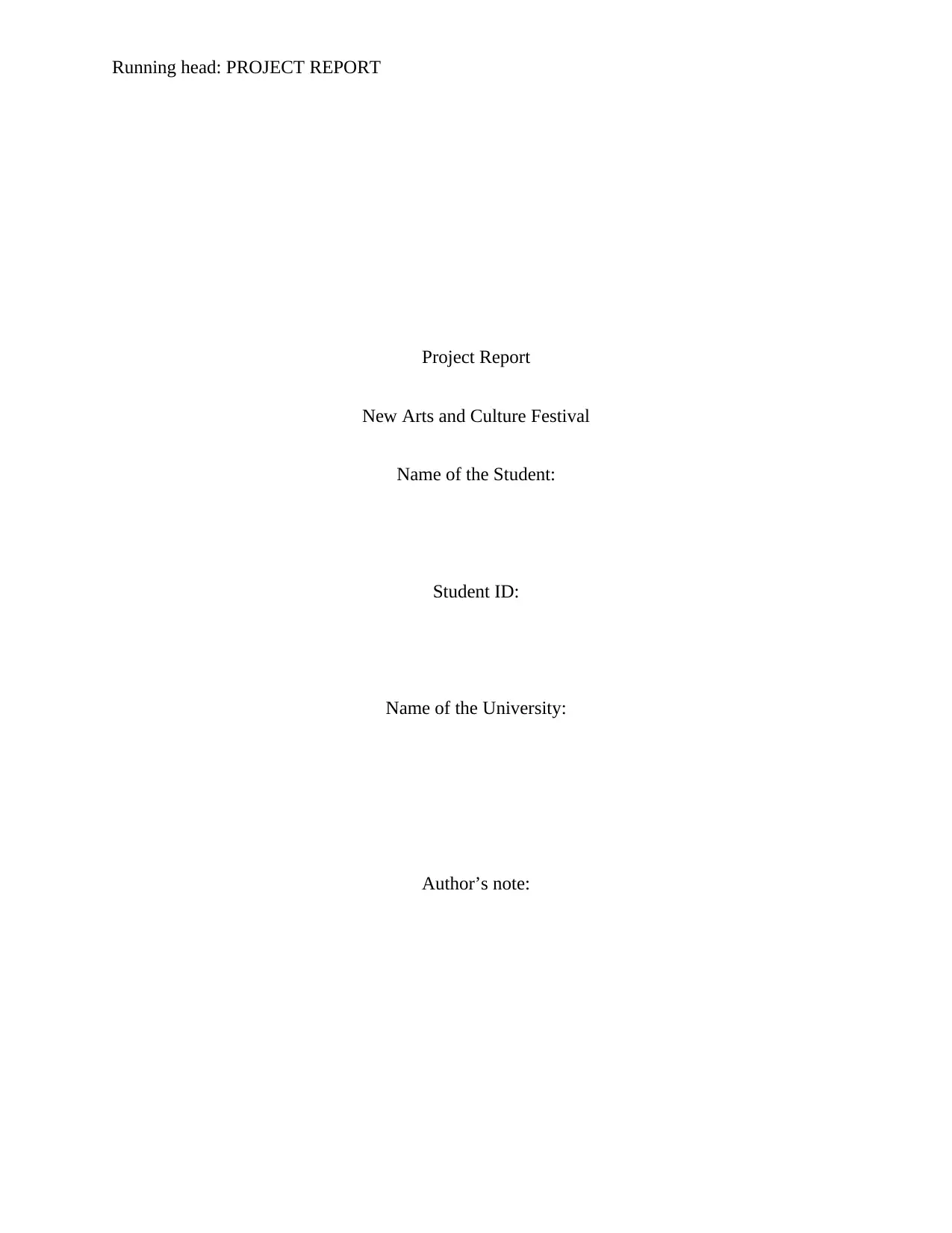
Running head: PROJECT REPORT
Project Report
New Arts and Culture Festival
Name of the Student:
Student ID:
Name of the University:
Author’s note:
Project Report
New Arts and Culture Festival
Name of the Student:
Student ID:
Name of the University:
Author’s note:
Paraphrase This Document
Need a fresh take? Get an instant paraphrase of this document with our AI Paraphraser
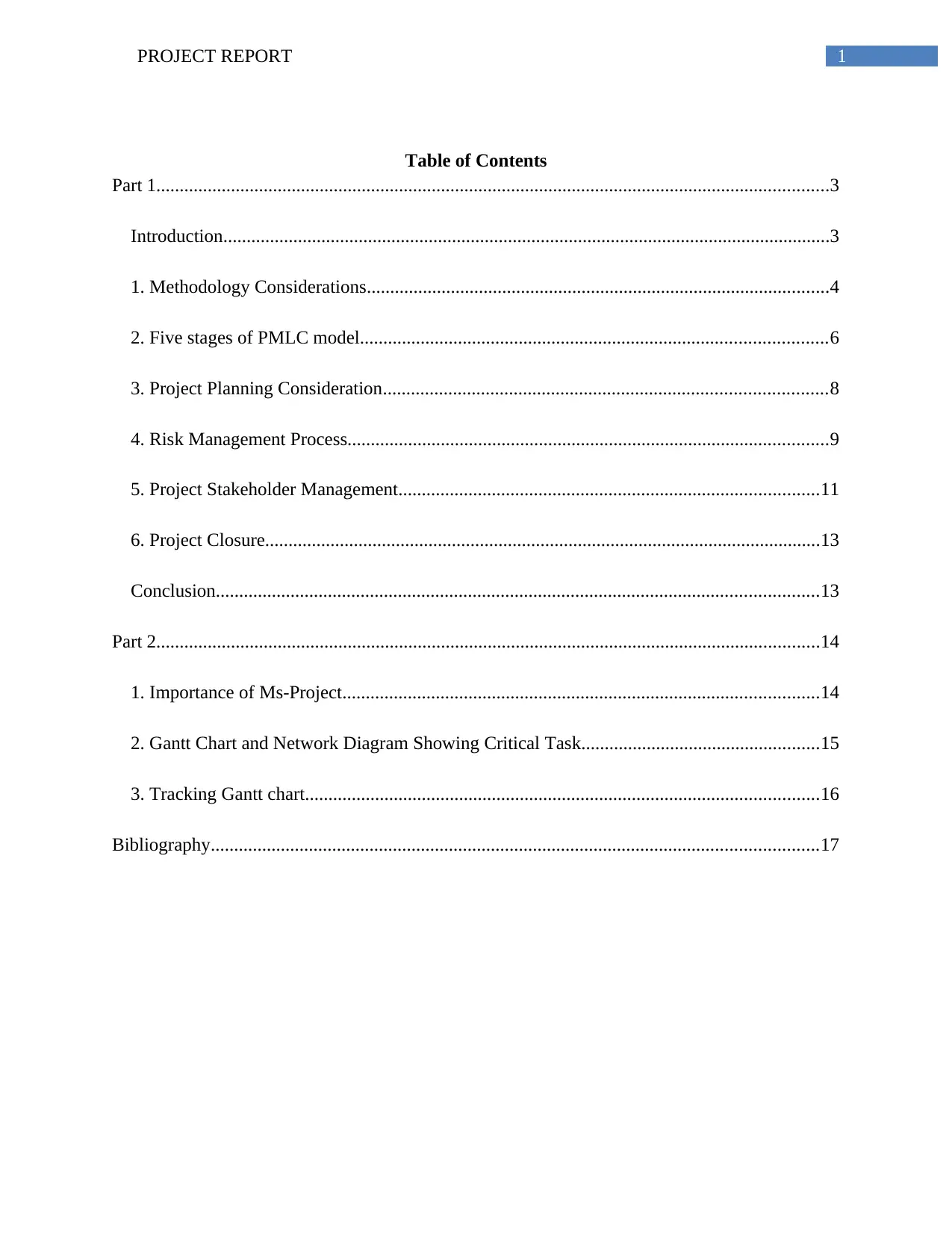
1PROJECT REPORT
Table of Contents
Part 1................................................................................................................................................3
Introduction..................................................................................................................................3
1. Methodology Considerations...................................................................................................4
2. Five stages of PMLC model....................................................................................................6
3. Project Planning Consideration...............................................................................................8
4. Risk Management Process.......................................................................................................9
5. Project Stakeholder Management..........................................................................................11
6. Project Closure.......................................................................................................................13
Conclusion.................................................................................................................................13
Part 2..............................................................................................................................................14
1. Importance of Ms-Project......................................................................................................14
2. Gantt Chart and Network Diagram Showing Critical Task...................................................15
3. Tracking Gantt chart..............................................................................................................16
Bibliography..................................................................................................................................17
Table of Contents
Part 1................................................................................................................................................3
Introduction..................................................................................................................................3
1. Methodology Considerations...................................................................................................4
2. Five stages of PMLC model....................................................................................................6
3. Project Planning Consideration...............................................................................................8
4. Risk Management Process.......................................................................................................9
5. Project Stakeholder Management..........................................................................................11
6. Project Closure.......................................................................................................................13
Conclusion.................................................................................................................................13
Part 2..............................................................................................................................................14
1. Importance of Ms-Project......................................................................................................14
2. Gantt Chart and Network Diagram Showing Critical Task...................................................15
3. Tracking Gantt chart..............................................................................................................16
Bibliography..................................................................................................................................17
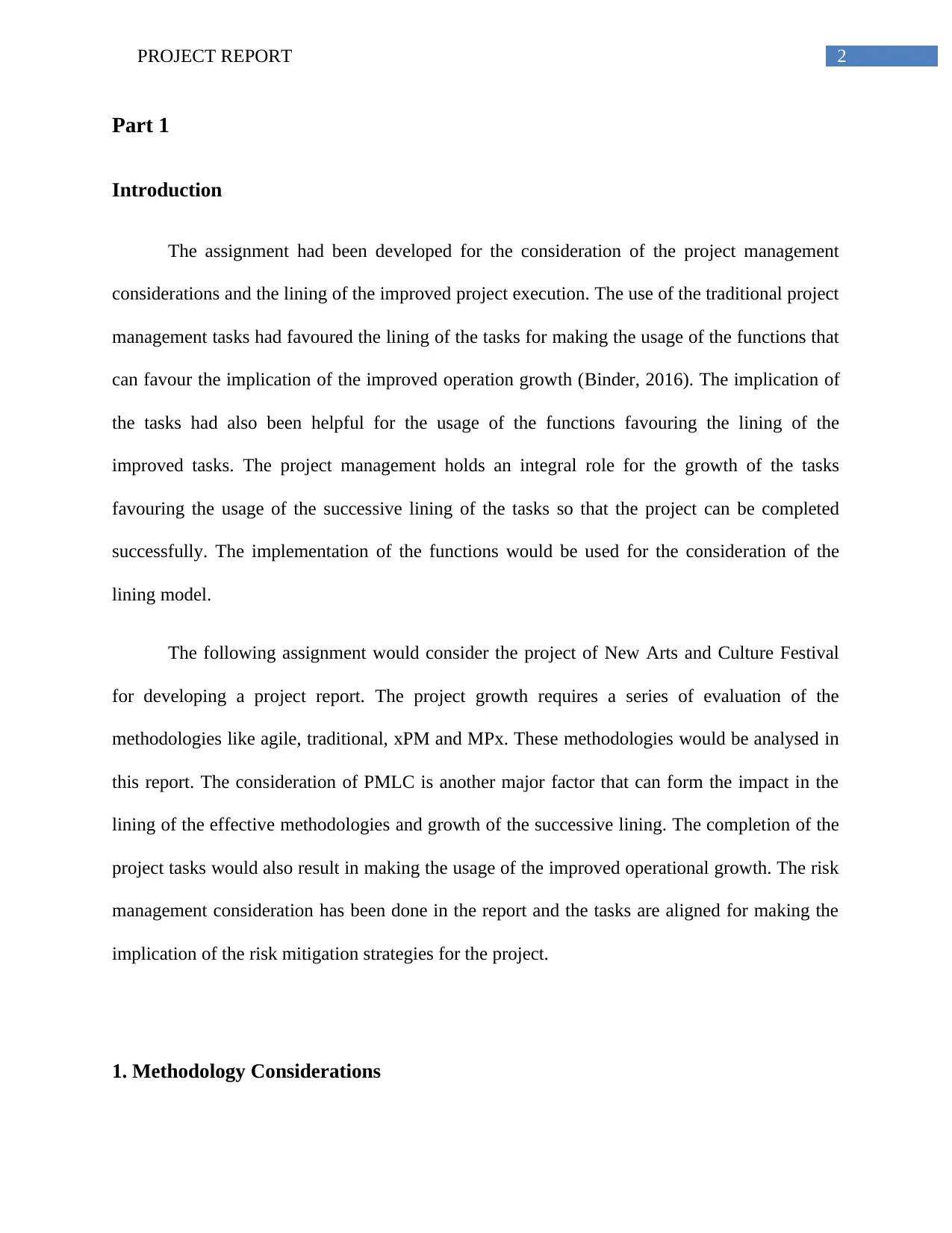
2PROJECT REPORT
Part 1
Introduction
The assignment had been developed for the consideration of the project management
considerations and the lining of the improved project execution. The use of the traditional project
management tasks had favoured the lining of the tasks for making the usage of the functions that
can favour the implication of the improved operation growth (Binder, 2016). The implication of
the tasks had also been helpful for the usage of the functions favouring the lining of the
improved tasks. The project management holds an integral role for the growth of the tasks
favouring the usage of the successive lining of the tasks so that the project can be completed
successfully. The implementation of the functions would be used for the consideration of the
lining model.
The following assignment would consider the project of New Arts and Culture Festival
for developing a project report. The project growth requires a series of evaluation of the
methodologies like agile, traditional, xPM and MPx. These methodologies would be analysed in
this report. The consideration of PMLC is another major factor that can form the impact in the
lining of the effective methodologies and growth of the successive lining. The completion of the
project tasks would also result in making the usage of the improved operational growth. The risk
management consideration has been done in the report and the tasks are aligned for making the
implication of the risk mitigation strategies for the project.
1. Methodology Considerations
Part 1
Introduction
The assignment had been developed for the consideration of the project management
considerations and the lining of the improved project execution. The use of the traditional project
management tasks had favoured the lining of the tasks for making the usage of the functions that
can favour the implication of the improved operation growth (Binder, 2016). The implication of
the tasks had also been helpful for the usage of the functions favouring the lining of the
improved tasks. The project management holds an integral role for the growth of the tasks
favouring the usage of the successive lining of the tasks so that the project can be completed
successfully. The implementation of the functions would be used for the consideration of the
lining model.
The following assignment would consider the project of New Arts and Culture Festival
for developing a project report. The project growth requires a series of evaluation of the
methodologies like agile, traditional, xPM and MPx. These methodologies would be analysed in
this report. The consideration of PMLC is another major factor that can form the impact in the
lining of the effective methodologies and growth of the successive lining. The completion of the
project tasks would also result in making the usage of the improved operational growth. The risk
management consideration has been done in the report and the tasks are aligned for making the
implication of the risk mitigation strategies for the project.
1. Methodology Considerations
⊘ This is a preview!⊘
Do you want full access?
Subscribe today to unlock all pages.

Trusted by 1+ million students worldwide
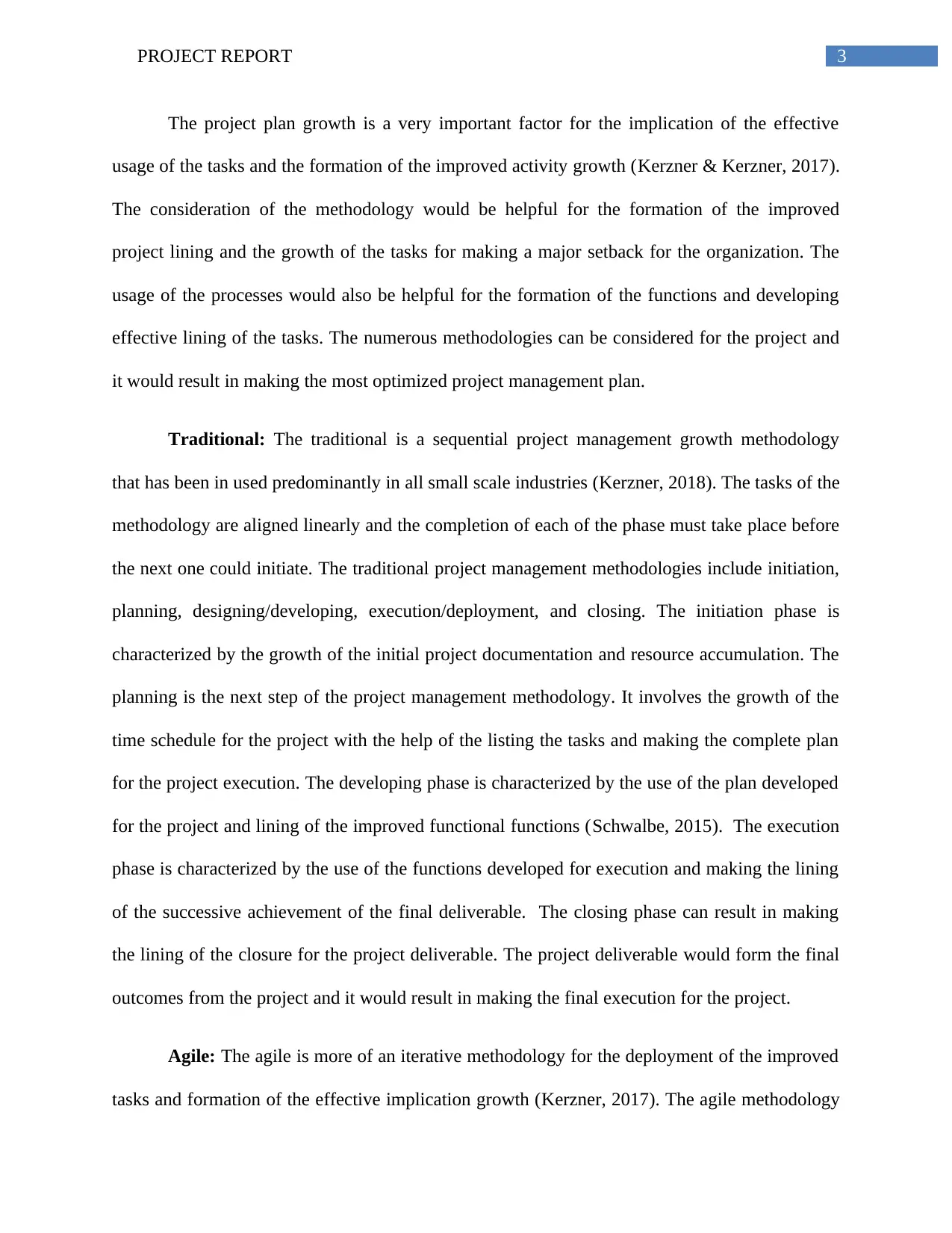
3PROJECT REPORT
The project plan growth is a very important factor for the implication of the effective
usage of the tasks and the formation of the improved activity growth (Kerzner & Kerzner, 2017).
The consideration of the methodology would be helpful for the formation of the improved
project lining and the growth of the tasks for making a major setback for the organization. The
usage of the processes would also be helpful for the formation of the functions and developing
effective lining of the tasks. The numerous methodologies can be considered for the project and
it would result in making the most optimized project management plan.
Traditional: The traditional is a sequential project management growth methodology
that has been in used predominantly in all small scale industries (Kerzner, 2018). The tasks of the
methodology are aligned linearly and the completion of each of the phase must take place before
the next one could initiate. The traditional project management methodologies include initiation,
planning, designing/developing, execution/deployment, and closing. The initiation phase is
characterized by the growth of the initial project documentation and resource accumulation. The
planning is the next step of the project management methodology. It involves the growth of the
time schedule for the project with the help of the listing the tasks and making the complete plan
for the project execution. The developing phase is characterized by the use of the plan developed
for the project and lining of the improved functional functions (Schwalbe, 2015). The execution
phase is characterized by the use of the functions developed for execution and making the lining
of the successive achievement of the final deliverable. The closing phase can result in making
the lining of the closure for the project deliverable. The project deliverable would form the final
outcomes from the project and it would result in making the final execution for the project.
Agile: The agile is more of an iterative methodology for the deployment of the improved
tasks and formation of the effective implication growth (Kerzner, 2017). The agile methodology
The project plan growth is a very important factor for the implication of the effective
usage of the tasks and the formation of the improved activity growth (Kerzner & Kerzner, 2017).
The consideration of the methodology would be helpful for the formation of the improved
project lining and the growth of the tasks for making a major setback for the organization. The
usage of the processes would also be helpful for the formation of the functions and developing
effective lining of the tasks. The numerous methodologies can be considered for the project and
it would result in making the most optimized project management plan.
Traditional: The traditional is a sequential project management growth methodology
that has been in used predominantly in all small scale industries (Kerzner, 2018). The tasks of the
methodology are aligned linearly and the completion of each of the phase must take place before
the next one could initiate. The traditional project management methodologies include initiation,
planning, designing/developing, execution/deployment, and closing. The initiation phase is
characterized by the growth of the initial project documentation and resource accumulation. The
planning is the next step of the project management methodology. It involves the growth of the
time schedule for the project with the help of the listing the tasks and making the complete plan
for the project execution. The developing phase is characterized by the use of the plan developed
for the project and lining of the improved functional functions (Schwalbe, 2015). The execution
phase is characterized by the use of the functions developed for execution and making the lining
of the successive achievement of the final deliverable. The closing phase can result in making
the lining of the closure for the project deliverable. The project deliverable would form the final
outcomes from the project and it would result in making the final execution for the project.
Agile: The agile is more of an iterative methodology for the deployment of the improved
tasks and formation of the effective implication growth (Kerzner, 2017). The agile methodology
Paraphrase This Document
Need a fresh take? Get an instant paraphrase of this document with our AI Paraphraser
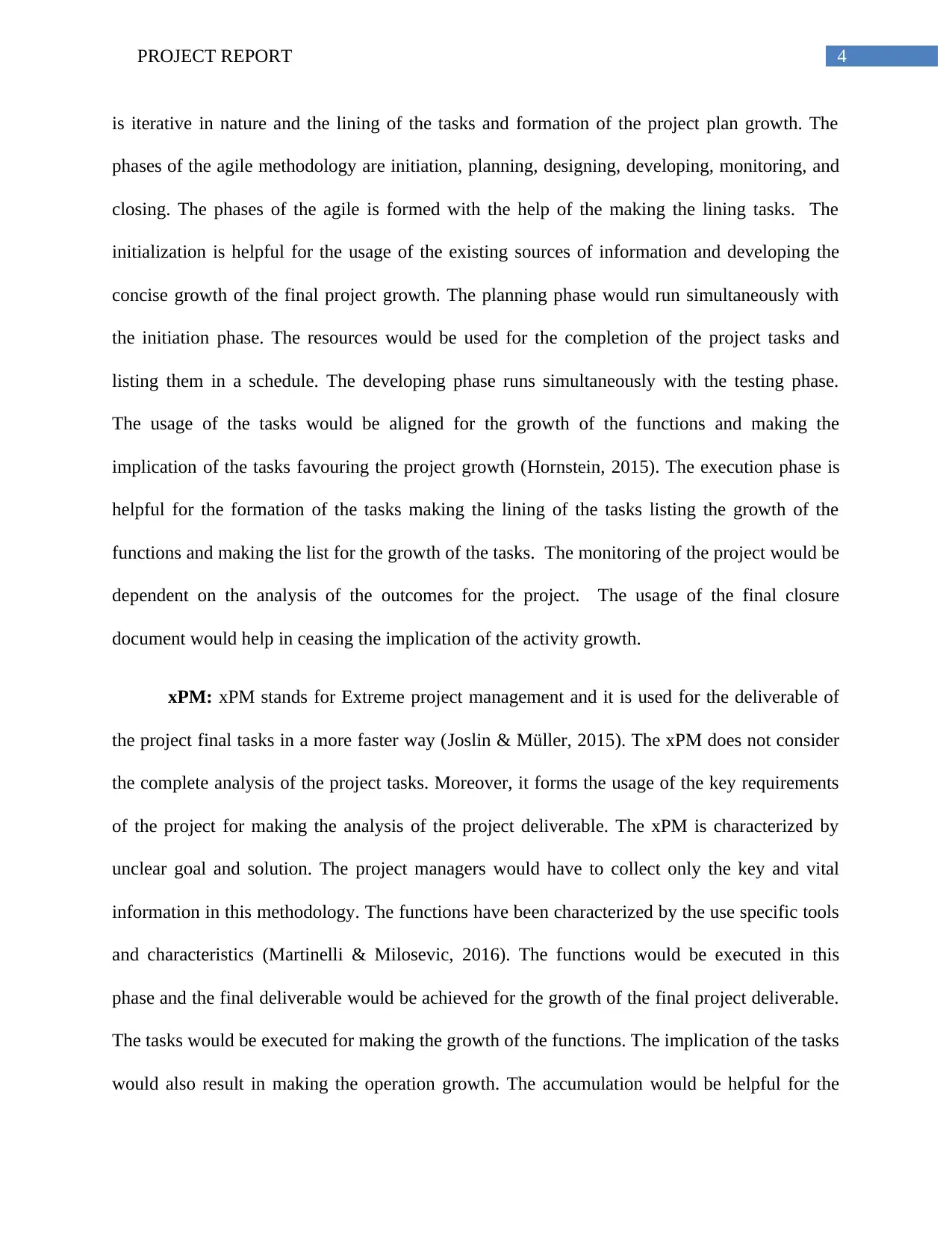
4PROJECT REPORT
is iterative in nature and the lining of the tasks and formation of the project plan growth. The
phases of the agile methodology are initiation, planning, designing, developing, monitoring, and
closing. The phases of the agile is formed with the help of the making the lining tasks. The
initialization is helpful for the usage of the existing sources of information and developing the
concise growth of the final project growth. The planning phase would run simultaneously with
the initiation phase. The resources would be used for the completion of the project tasks and
listing them in a schedule. The developing phase runs simultaneously with the testing phase.
The usage of the tasks would be aligned for the growth of the functions and making the
implication of the tasks favouring the project growth (Hornstein, 2015). The execution phase is
helpful for the formation of the tasks making the lining of the tasks listing the growth of the
functions and making the list for the growth of the tasks. The monitoring of the project would be
dependent on the analysis of the outcomes for the project. The usage of the final closure
document would help in ceasing the implication of the activity growth.
xPM: xPM stands for Extreme project management and it is used for the deliverable of
the project final tasks in a more faster way (Joslin & Müller, 2015). The xPM does not consider
the complete analysis of the project tasks. Moreover, it forms the usage of the key requirements
of the project for making the analysis of the project deliverable. The xPM is characterized by
unclear goal and solution. The project managers would have to collect only the key and vital
information in this methodology. The functions have been characterized by the use specific tools
and characteristics (Martinelli & Milosevic, 2016). The functions would be executed in this
phase and the final deliverable would be achieved for the growth of the final project deliverable.
The tasks would be executed for making the growth of the functions. The implication of the tasks
would also result in making the operation growth. The accumulation would be helpful for the
is iterative in nature and the lining of the tasks and formation of the project plan growth. The
phases of the agile methodology are initiation, planning, designing, developing, monitoring, and
closing. The phases of the agile is formed with the help of the making the lining tasks. The
initialization is helpful for the usage of the existing sources of information and developing the
concise growth of the final project growth. The planning phase would run simultaneously with
the initiation phase. The resources would be used for the completion of the project tasks and
listing them in a schedule. The developing phase runs simultaneously with the testing phase.
The usage of the tasks would be aligned for the growth of the functions and making the
implication of the tasks favouring the project growth (Hornstein, 2015). The execution phase is
helpful for the formation of the tasks making the lining of the tasks listing the growth of the
functions and making the list for the growth of the tasks. The monitoring of the project would be
dependent on the analysis of the outcomes for the project. The usage of the final closure
document would help in ceasing the implication of the activity growth.
xPM: xPM stands for Extreme project management and it is used for the deliverable of
the project final tasks in a more faster way (Joslin & Müller, 2015). The xPM does not consider
the complete analysis of the project tasks. Moreover, it forms the usage of the key requirements
of the project for making the analysis of the project deliverable. The xPM is characterized by
unclear goal and solution. The project managers would have to collect only the key and vital
information in this methodology. The functions have been characterized by the use specific tools
and characteristics (Martinelli & Milosevic, 2016). The functions would be executed in this
phase and the final deliverable would be achieved for the growth of the final project deliverable.
The tasks would be executed for making the growth of the functions. The implication of the tasks
would also result in making the operation growth. The accumulation would be helpful for the
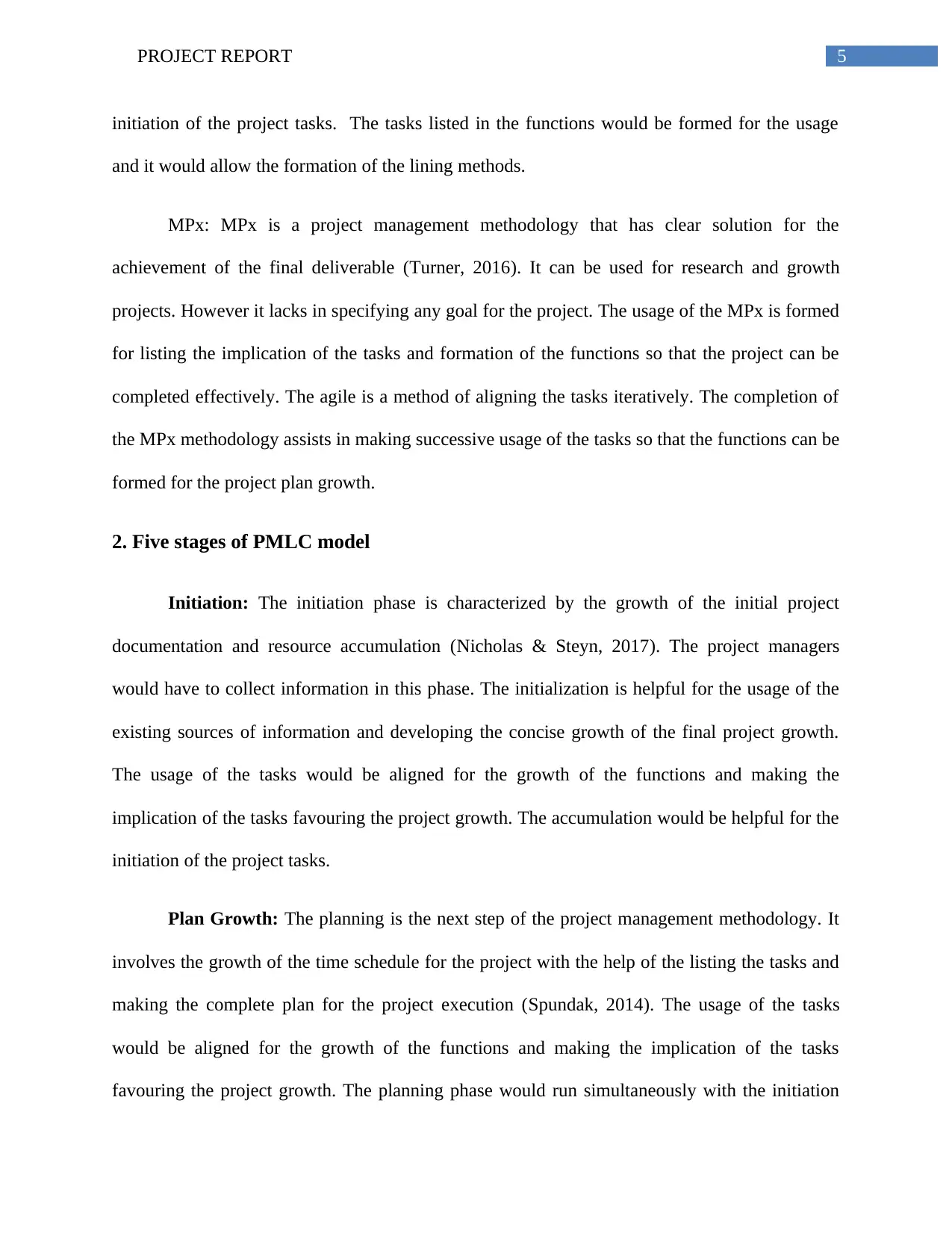
5PROJECT REPORT
initiation of the project tasks. The tasks listed in the functions would be formed for the usage
and it would allow the formation of the lining methods.
MPx: MPx is a project management methodology that has clear solution for the
achievement of the final deliverable (Turner, 2016). It can be used for research and growth
projects. However it lacks in specifying any goal for the project. The usage of the MPx is formed
for listing the implication of the tasks and formation of the functions so that the project can be
completed effectively. The agile is a method of aligning the tasks iteratively. The completion of
the MPx methodology assists in making successive usage of the tasks so that the functions can be
formed for the project plan growth.
2. Five stages of PMLC model
Initiation: The initiation phase is characterized by the growth of the initial project
documentation and resource accumulation (Nicholas & Steyn, 2017). The project managers
would have to collect information in this phase. The initialization is helpful for the usage of the
existing sources of information and developing the concise growth of the final project growth.
The usage of the tasks would be aligned for the growth of the functions and making the
implication of the tasks favouring the project growth. The accumulation would be helpful for the
initiation of the project tasks.
Plan Growth: The planning is the next step of the project management methodology. It
involves the growth of the time schedule for the project with the help of the listing the tasks and
making the complete plan for the project execution (Spundak, 2014). The usage of the tasks
would be aligned for the growth of the functions and making the implication of the tasks
favouring the project growth. The planning phase would run simultaneously with the initiation
initiation of the project tasks. The tasks listed in the functions would be formed for the usage
and it would allow the formation of the lining methods.
MPx: MPx is a project management methodology that has clear solution for the
achievement of the final deliverable (Turner, 2016). It can be used for research and growth
projects. However it lacks in specifying any goal for the project. The usage of the MPx is formed
for listing the implication of the tasks and formation of the functions so that the project can be
completed effectively. The agile is a method of aligning the tasks iteratively. The completion of
the MPx methodology assists in making successive usage of the tasks so that the functions can be
formed for the project plan growth.
2. Five stages of PMLC model
Initiation: The initiation phase is characterized by the growth of the initial project
documentation and resource accumulation (Nicholas & Steyn, 2017). The project managers
would have to collect information in this phase. The initialization is helpful for the usage of the
existing sources of information and developing the concise growth of the final project growth.
The usage of the tasks would be aligned for the growth of the functions and making the
implication of the tasks favouring the project growth. The accumulation would be helpful for the
initiation of the project tasks.
Plan Growth: The planning is the next step of the project management methodology. It
involves the growth of the time schedule for the project with the help of the listing the tasks and
making the complete plan for the project execution (Spundak, 2014). The usage of the tasks
would be aligned for the growth of the functions and making the implication of the tasks
favouring the project growth. The planning phase would run simultaneously with the initiation
⊘ This is a preview!⊘
Do you want full access?
Subscribe today to unlock all pages.

Trusted by 1+ million students worldwide
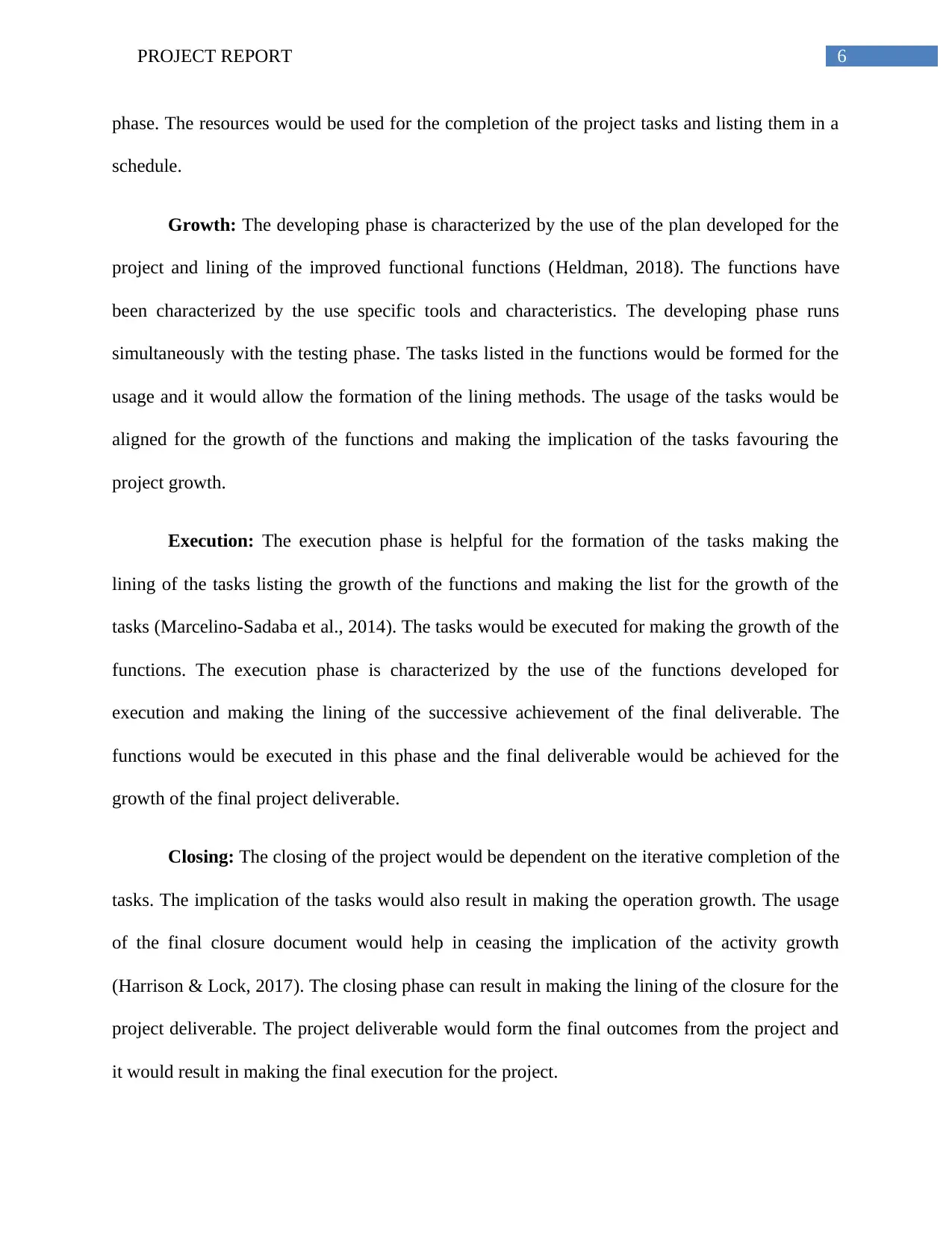
6PROJECT REPORT
phase. The resources would be used for the completion of the project tasks and listing them in a
schedule.
Growth: The developing phase is characterized by the use of the plan developed for the
project and lining of the improved functional functions (Heldman, 2018). The functions have
been characterized by the use specific tools and characteristics. The developing phase runs
simultaneously with the testing phase. The tasks listed in the functions would be formed for the
usage and it would allow the formation of the lining methods. The usage of the tasks would be
aligned for the growth of the functions and making the implication of the tasks favouring the
project growth.
Execution: The execution phase is helpful for the formation of the tasks making the
lining of the tasks listing the growth of the functions and making the list for the growth of the
tasks (Marcelino-Sadaba et al., 2014). The tasks would be executed for making the growth of the
functions. The execution phase is characterized by the use of the functions developed for
execution and making the lining of the successive achievement of the final deliverable. The
functions would be executed in this phase and the final deliverable would be achieved for the
growth of the final project deliverable.
Closing: The closing of the project would be dependent on the iterative completion of the
tasks. The implication of the tasks would also result in making the operation growth. The usage
of the final closure document would help in ceasing the implication of the activity growth
(Harrison & Lock, 2017). The closing phase can result in making the lining of the closure for the
project deliverable. The project deliverable would form the final outcomes from the project and
it would result in making the final execution for the project.
phase. The resources would be used for the completion of the project tasks and listing them in a
schedule.
Growth: The developing phase is characterized by the use of the plan developed for the
project and lining of the improved functional functions (Heldman, 2018). The functions have
been characterized by the use specific tools and characteristics. The developing phase runs
simultaneously with the testing phase. The tasks listed in the functions would be formed for the
usage and it would allow the formation of the lining methods. The usage of the tasks would be
aligned for the growth of the functions and making the implication of the tasks favouring the
project growth.
Execution: The execution phase is helpful for the formation of the tasks making the
lining of the tasks listing the growth of the functions and making the list for the growth of the
tasks (Marcelino-Sadaba et al., 2014). The tasks would be executed for making the growth of the
functions. The execution phase is characterized by the use of the functions developed for
execution and making the lining of the successive achievement of the final deliverable. The
functions would be executed in this phase and the final deliverable would be achieved for the
growth of the final project deliverable.
Closing: The closing of the project would be dependent on the iterative completion of the
tasks. The implication of the tasks would also result in making the operation growth. The usage
of the final closure document would help in ceasing the implication of the activity growth
(Harrison & Lock, 2017). The closing phase can result in making the lining of the closure for the
project deliverable. The project deliverable would form the final outcomes from the project and
it would result in making the final execution for the project.
Paraphrase This Document
Need a fresh take? Get an instant paraphrase of this document with our AI Paraphraser
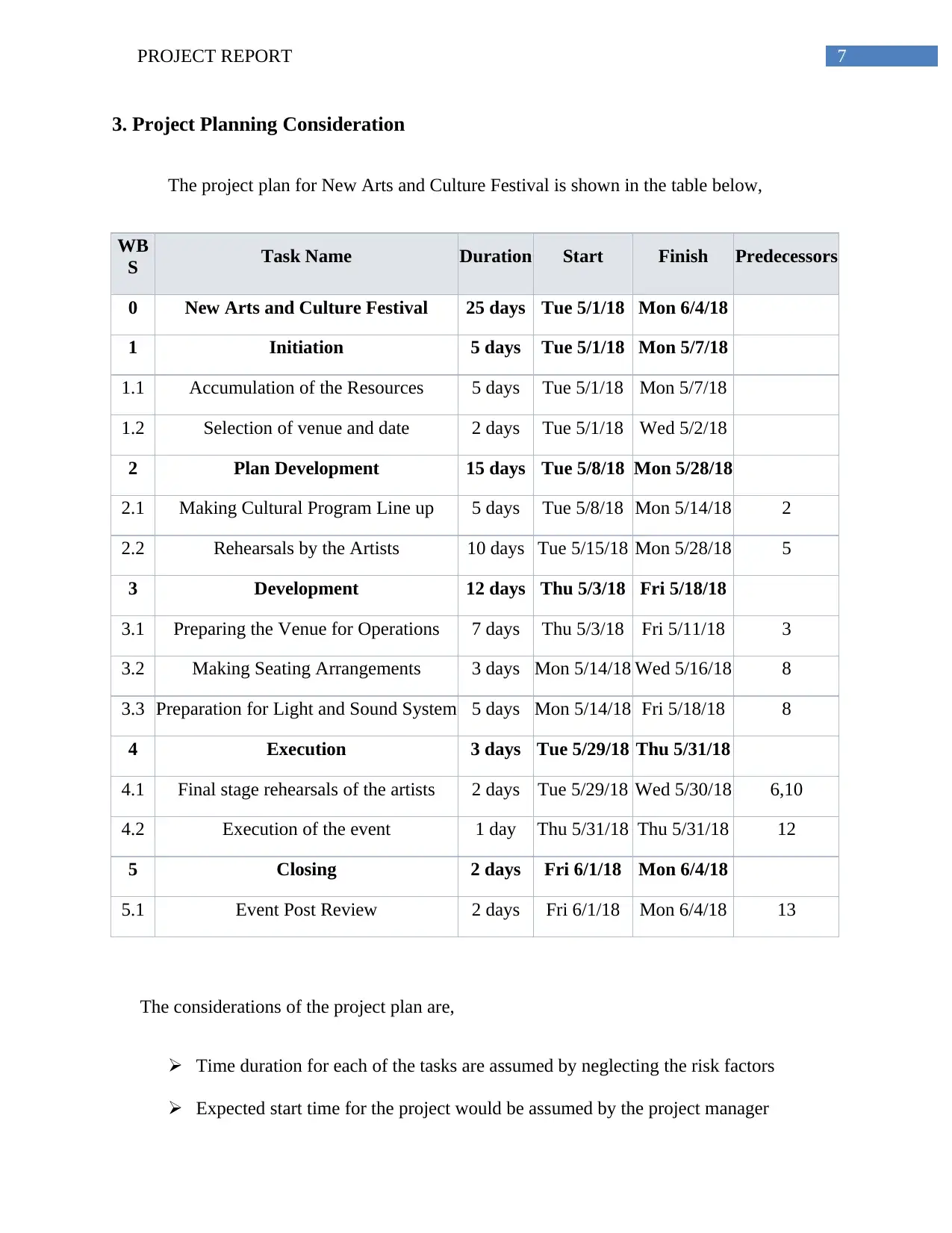
7PROJECT REPORT
3. Project Planning Consideration
The project plan for New Arts and Culture Festival is shown in the table below,
WB
S Task Name Duration Start Finish Predecessors
0 New Arts and Culture Festival 25 days Tue 5/1/18 Mon 6/4/18
1 Initiation 5 days Tue 5/1/18 Mon 5/7/18
1.1 Accumulation of the Resources 5 days Tue 5/1/18 Mon 5/7/18
1.2 Selection of venue and date 2 days Tue 5/1/18 Wed 5/2/18
2 Plan Development 15 days Tue 5/8/18 Mon 5/28/18
2.1 Making Cultural Program Line up 5 days Tue 5/8/18 Mon 5/14/18 2
2.2 Rehearsals by the Artists 10 days Tue 5/15/18 Mon 5/28/18 5
3 Development 12 days Thu 5/3/18 Fri 5/18/18
3.1 Preparing the Venue for Operations 7 days Thu 5/3/18 Fri 5/11/18 3
3.2 Making Seating Arrangements 3 days Mon 5/14/18 Wed 5/16/18 8
3.3 Preparation for Light and Sound System 5 days Mon 5/14/18 Fri 5/18/18 8
4 Execution 3 days Tue 5/29/18 Thu 5/31/18
4.1 Final stage rehearsals of the artists 2 days Tue 5/29/18 Wed 5/30/18 6,10
4.2 Execution of the event 1 day Thu 5/31/18 Thu 5/31/18 12
5 Closing 2 days Fri 6/1/18 Mon 6/4/18
5.1 Event Post Review 2 days Fri 6/1/18 Mon 6/4/18 13
The considerations of the project plan are,
Time duration for each of the tasks are assumed by neglecting the risk factors
Expected start time for the project would be assumed by the project manager
3. Project Planning Consideration
The project plan for New Arts and Culture Festival is shown in the table below,
WB
S Task Name Duration Start Finish Predecessors
0 New Arts and Culture Festival 25 days Tue 5/1/18 Mon 6/4/18
1 Initiation 5 days Tue 5/1/18 Mon 5/7/18
1.1 Accumulation of the Resources 5 days Tue 5/1/18 Mon 5/7/18
1.2 Selection of venue and date 2 days Tue 5/1/18 Wed 5/2/18
2 Plan Development 15 days Tue 5/8/18 Mon 5/28/18
2.1 Making Cultural Program Line up 5 days Tue 5/8/18 Mon 5/14/18 2
2.2 Rehearsals by the Artists 10 days Tue 5/15/18 Mon 5/28/18 5
3 Development 12 days Thu 5/3/18 Fri 5/18/18
3.1 Preparing the Venue for Operations 7 days Thu 5/3/18 Fri 5/11/18 3
3.2 Making Seating Arrangements 3 days Mon 5/14/18 Wed 5/16/18 8
3.3 Preparation for Light and Sound System 5 days Mon 5/14/18 Fri 5/18/18 8
4 Execution 3 days Tue 5/29/18 Thu 5/31/18
4.1 Final stage rehearsals of the artists 2 days Tue 5/29/18 Wed 5/30/18 6,10
4.2 Execution of the event 1 day Thu 5/31/18 Thu 5/31/18 12
5 Closing 2 days Fri 6/1/18 Mon 6/4/18
5.1 Event Post Review 2 days Fri 6/1/18 Mon 6/4/18 13
The considerations of the project plan are,
Time duration for each of the tasks are assumed by neglecting the risk factors
Expected start time for the project would be assumed by the project manager
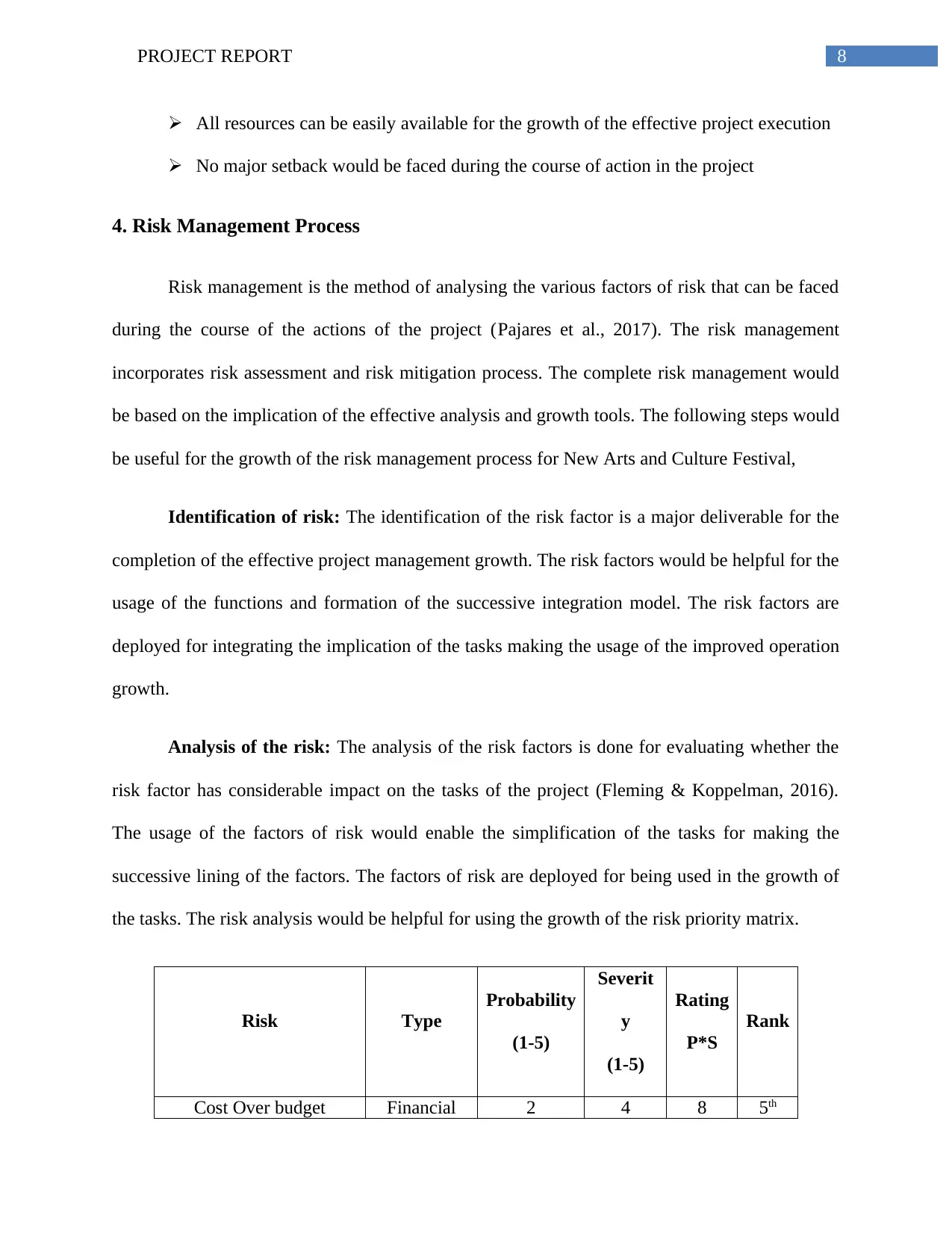
8PROJECT REPORT
All resources can be easily available for the growth of the effective project execution
No major setback would be faced during the course of action in the project
4. Risk Management Process
Risk management is the method of analysing the various factors of risk that can be faced
during the course of the actions of the project (Pajares et al., 2017). The risk management
incorporates risk assessment and risk mitigation process. The complete risk management would
be based on the implication of the effective analysis and growth tools. The following steps would
be useful for the growth of the risk management process for New Arts and Culture Festival,
Identification of risk: The identification of the risk factor is a major deliverable for the
completion of the effective project management growth. The risk factors would be helpful for the
usage of the functions and formation of the successive integration model. The risk factors are
deployed for integrating the implication of the tasks making the usage of the improved operation
growth.
Analysis of the risk: The analysis of the risk factors is done for evaluating whether the
risk factor has considerable impact on the tasks of the project (Fleming & Koppelman, 2016).
The usage of the factors of risk would enable the simplification of the tasks for making the
successive lining of the factors. The factors of risk are deployed for being used in the growth of
the tasks. The risk analysis would be helpful for using the growth of the risk priority matrix.
Risk Type
Probability
(1-5)
Severit
y
(1-5)
Rating
P*S
Rank
Cost Over budget Financial 2 4 8 5th
All resources can be easily available for the growth of the effective project execution
No major setback would be faced during the course of action in the project
4. Risk Management Process
Risk management is the method of analysing the various factors of risk that can be faced
during the course of the actions of the project (Pajares et al., 2017). The risk management
incorporates risk assessment and risk mitigation process. The complete risk management would
be based on the implication of the effective analysis and growth tools. The following steps would
be useful for the growth of the risk management process for New Arts and Culture Festival,
Identification of risk: The identification of the risk factor is a major deliverable for the
completion of the effective project management growth. The risk factors would be helpful for the
usage of the functions and formation of the successive integration model. The risk factors are
deployed for integrating the implication of the tasks making the usage of the improved operation
growth.
Analysis of the risk: The analysis of the risk factors is done for evaluating whether the
risk factor has considerable impact on the tasks of the project (Fleming & Koppelman, 2016).
The usage of the factors of risk would enable the simplification of the tasks for making the
successive lining of the factors. The factors of risk are deployed for being used in the growth of
the tasks. The risk analysis would be helpful for using the growth of the risk priority matrix.
Risk Type
Probability
(1-5)
Severit
y
(1-5)
Rating
P*S
Rank
Cost Over budget Financial 2 4 8 5th
⊘ This is a preview!⊘
Do you want full access?
Subscribe today to unlock all pages.

Trusted by 1+ million students worldwide
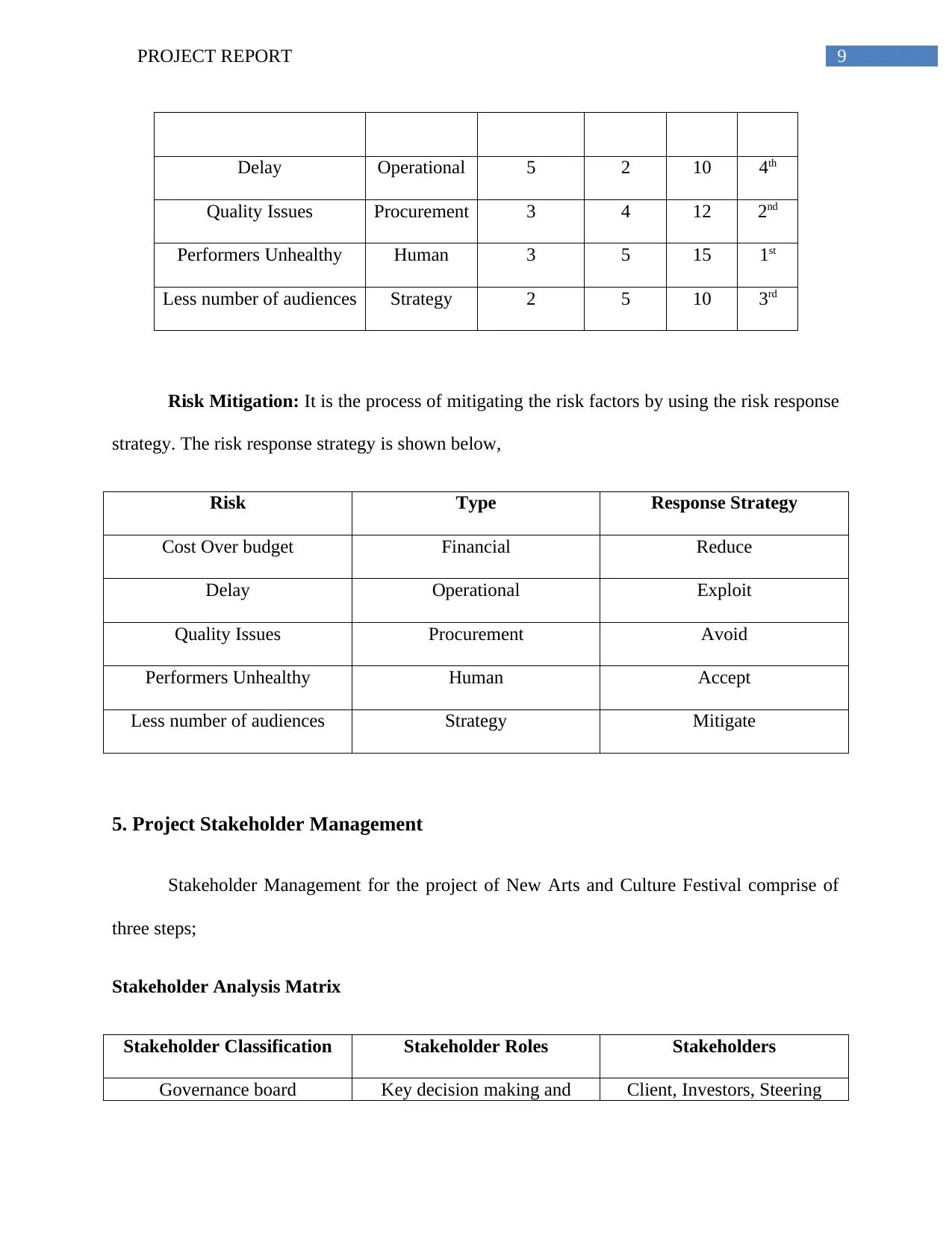
9PROJECT REPORT
Delay Operational 5 2 10 4th
Quality Issues Procurement 3 4 12 2nd
Performers Unhealthy Human 3 5 15 1st
Less number of audiences Strategy 2 5 10 3rd
Risk Mitigation: It is the process of mitigating the risk factors by using the risk response
strategy. The risk response strategy is shown below,
Risk Type Response Strategy
Cost Over budget Financial Reduce
Delay Operational Exploit
Quality Issues Procurement Avoid
Performers Unhealthy Human Accept
Less number of audiences Strategy Mitigate
5. Project Stakeholder Management
Stakeholder Management for the project of New Arts and Culture Festival comprise of
three steps;
Stakeholder Analysis Matrix
Stakeholder Classification Stakeholder Roles Stakeholders
Governance board Key decision making and Client, Investors, Steering
Delay Operational 5 2 10 4th
Quality Issues Procurement 3 4 12 2nd
Performers Unhealthy Human 3 5 15 1st
Less number of audiences Strategy 2 5 10 3rd
Risk Mitigation: It is the process of mitigating the risk factors by using the risk response
strategy. The risk response strategy is shown below,
Risk Type Response Strategy
Cost Over budget Financial Reduce
Delay Operational Exploit
Quality Issues Procurement Avoid
Performers Unhealthy Human Accept
Less number of audiences Strategy Mitigate
5. Project Stakeholder Management
Stakeholder Management for the project of New Arts and Culture Festival comprise of
three steps;
Stakeholder Analysis Matrix
Stakeholder Classification Stakeholder Roles Stakeholders
Governance board Key decision making and Client, Investors, Steering
Paraphrase This Document
Need a fresh take? Get an instant paraphrase of this document with our AI Paraphraser
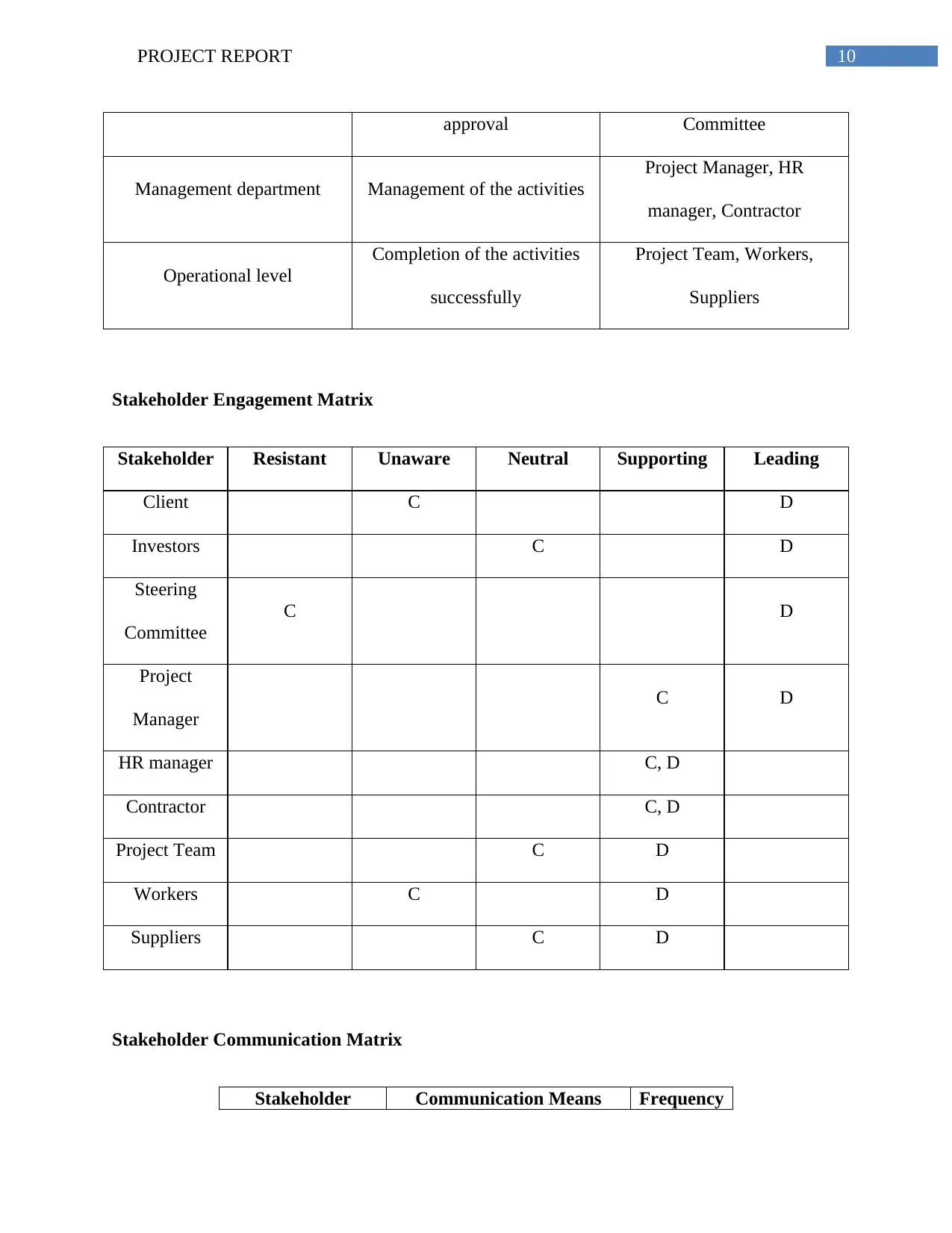
10PROJECT REPORT
approval Committee
Management department Management of the activities
Project Manager, HR
manager, Contractor
Operational level
Completion of the activities
successfully
Project Team, Workers,
Suppliers
Stakeholder Engagement Matrix
Stakeholder Resistant Unaware Neutral Supporting Leading
Client C D
Investors C D
Steering
Committee
C D
Project
Manager
C D
HR manager C, D
Contractor C, D
Project Team C D
Workers C D
Suppliers C D
Stakeholder Communication Matrix
Stakeholder Communication Means Frequency
approval Committee
Management department Management of the activities
Project Manager, HR
manager, Contractor
Operational level
Completion of the activities
successfully
Project Team, Workers,
Suppliers
Stakeholder Engagement Matrix
Stakeholder Resistant Unaware Neutral Supporting Leading
Client C D
Investors C D
Steering
Committee
C D
Project
Manager
C D
HR manager C, D
Contractor C, D
Project Team C D
Workers C D
Suppliers C D
Stakeholder Communication Matrix
Stakeholder Communication Means Frequency
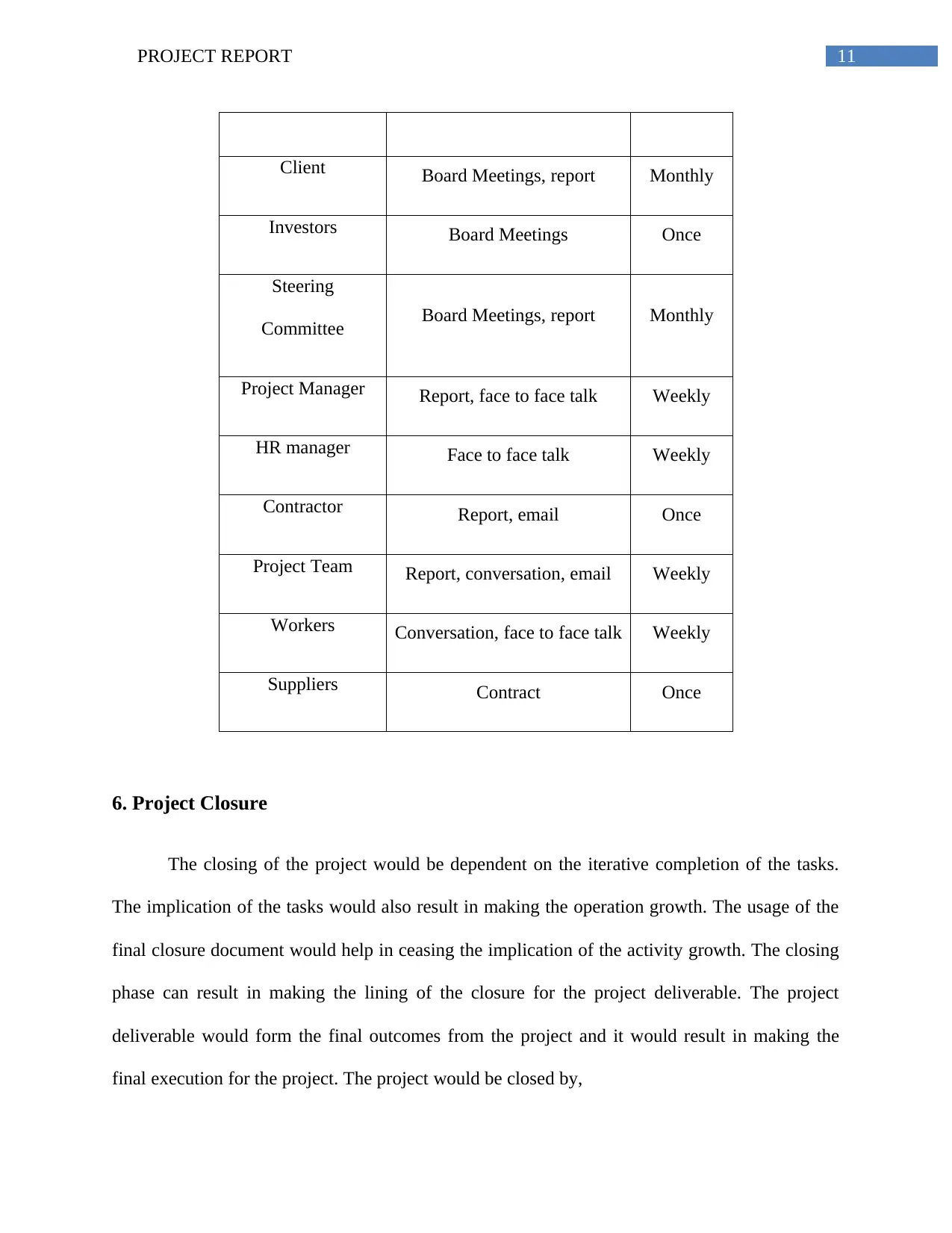
11PROJECT REPORT
Client Board Meetings, report Monthly
Investors Board Meetings Once
Steering
Committee Board Meetings, report Monthly
Project Manager Report, face to face talk Weekly
HR manager Face to face talk Weekly
Contractor Report, email Once
Project Team Report, conversation, email Weekly
Workers Conversation, face to face talk Weekly
Suppliers Contract Once
6. Project Closure
The closing of the project would be dependent on the iterative completion of the tasks.
The implication of the tasks would also result in making the operation growth. The usage of the
final closure document would help in ceasing the implication of the activity growth. The closing
phase can result in making the lining of the closure for the project deliverable. The project
deliverable would form the final outcomes from the project and it would result in making the
final execution for the project. The project would be closed by,
Client Board Meetings, report Monthly
Investors Board Meetings Once
Steering
Committee Board Meetings, report Monthly
Project Manager Report, face to face talk Weekly
HR manager Face to face talk Weekly
Contractor Report, email Once
Project Team Report, conversation, email Weekly
Workers Conversation, face to face talk Weekly
Suppliers Contract Once
6. Project Closure
The closing of the project would be dependent on the iterative completion of the tasks.
The implication of the tasks would also result in making the operation growth. The usage of the
final closure document would help in ceasing the implication of the activity growth. The closing
phase can result in making the lining of the closure for the project deliverable. The project
deliverable would form the final outcomes from the project and it would result in making the
final execution for the project. The project would be closed by,
⊘ This is a preview!⊘
Do you want full access?
Subscribe today to unlock all pages.

Trusted by 1+ million students worldwide
1 out of 18
Related Documents
Your All-in-One AI-Powered Toolkit for Academic Success.
+13062052269
info@desklib.com
Available 24*7 on WhatsApp / Email
![[object Object]](/_next/static/media/star-bottom.7253800d.svg)
Unlock your academic potential
Copyright © 2020–2025 A2Z Services. All Rights Reserved. Developed and managed by ZUCOL.





